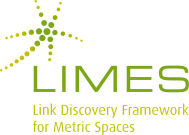The Linked Data paradigm builds upon the backbone of distributed knowledge bases connected by typed links. The aim of Link Discovery is to identify the set {(s, t) ∈ S × T : R(s, t)} given an input relation R and two sets S (source) and T (target) of RDF resources. The mere size of current knowledge bases as well as their sheer number pose two major challenges when aiming to support the computation of links across and within them. The first is that tools for link discovery have to be time-efficient when they compute links. Secondly, these tools have to produce links of high quality to serve the applications built upon Linked Data well.
<link http: aksw.org projects limes>LIMES is a link discovery framework for the Web of Data, which implements time-efficient approaches for large-scale link discovery based on the characteristics of metric spaces. <link http: aksw.org projects limes>LIMES is easily configurable via a configuration file as well as through a graphical user interface. <link http: aksw.org projects limes>LIMES can be downloaded as standalone tool for carrying out link discovery or as a Java library.
The current version of the LIMES framework is the product of seven years of research on these two challenges. The framework combines diverse algorithms for link discovery within a generic and extensible architecture.
<link http: aksw.org projects limes.html>LIMES implements novel time-efficient approaches for link discovery in metric spaces. Such approaches facilitate different approximation techniques to compute estimates of the similarity between instances. These estimates are then used to filter out a large number of those instance pairs that do not suffice the mapping conditions. By these means, <link http: aksw.org projects limes.html>LIMES can reduce the number of comparisons needed during the mapping process by several orders of magnitude. The approaches implemented in <link http: aksw.org projects limes>LIMES include the <link http: ijcai.org papers11 papers ijcai11-385.pdf>original LIMES algorithm for edit distances,<link http: link.springer.com chapter> HR3,<link http: link.springer.com article> HYPPO, and<link http: link.springer.com chapter> ORCHID. Additionally, <link http: aksw.org projects limes.html>LIMES supports the first planning technique for link discovery<link http: iswc2014.semanticweb.org raw.githubusercontent.com lidingpku iswc2014 master paper> HELIOS, that minimizes the overall execution of a link specification, without any loss of completeness. Moreover, <link http: aksw.org projects limes.html>LIMES implements supervised and unsupervised machine-learning algorithms for finding accurate link specifications. The algorithms implemented here include the supervised, active and unsupervised versions of<link http: svn.aksw.org papers eswc_eagle public.pdf> EAGLE and <link http: svn.aksw.org papers eswc_wombat public.pdf>WOMBAT.
In addition to supporting configurations as input files, <link http: aksw.org projects limes.html>LIMES provides a graphical user interface (GUI) to assist the end user during the LD process. The GUI provides wizards which ease the link specification creation process and allow configuration of the machine learning algorithms.
<link http: aksw.org projects limes.html>LIMES includes a set of manuals, with a comprehensive guide about the tool, that includes:
<link http: dice-group.github.io limes user_manual>User manual, with details on how to use and configure the <link http: aksw.org projects limes.html>LIMES Java application;
<link http: dice-group.github.io limes developer_manual>Developer manual, which describes the internal design and the fundamental building blocks of <link http: aksw.org projects limes.html>LIMES. This guide is suitable for those who want to either extend it or embed it into their own software products. It aims to deliver an overview of the architecture underlying our framework, explain the core concepts and give developers entry points into the java docs for further reading.
<link http: aksw.org projects limes.html>LIMES is open-source and available under a <link https: github.com dice-group limes blob master license>dual license at <link https: github.com dice-group limes>github.com/dice-group/LIMES. For further theoretical details about the approaches implemented in <link http: aksw.org projects limes>LIMES, please visit the project<link http: aksw.org projects limes.html> web site where you can find more than 30 peer-reviewed and published papers in top conferences and journals.

